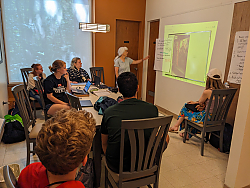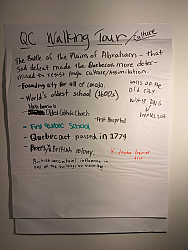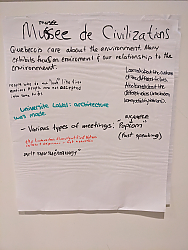Learning about First Nations in Wendake, including reflections from Ava and Rosie
Sunday, July 23:
After breakfast at the university dining hall, we gathered in our classroom space for a discussion of the sites we have seen thus far, tying them into the Intercultural Communication topics we've learned about during class in Putney, such as Edward T. Hall's iceberg model of culture; and concepts of acculturation, assimilation, cultural appropriation, and cultural appreciation.



Afterwards, we traveled to the nearby town of Wendake, where we observed that once we entered the First Nations reservation, street signs were in part written in Wendat language. We visited the Onhoüa Chetek8e interpretive site, which is a recreated indigenous village. We learned that the English term "Huron" is considered offensive - it was given to the Wendat people because the French settlers thought their tufted hairstyles looked like the head of a boar (hure). Wendat is the preferred name. Our tour guide, Stephanie, taught us about the history of the Wendat people, including their traditional homes, crafts, methods of medicine and healing, and their domestic and political life structures. Here she is showing us how canoes and snowshoes are made using traditional methods:

Upon arrival we observed a Wendat dance, traditionally used to welcome visitors (and newborn babies) to the Wendat community.

***
Students Ava and Rosie were responsible for blogging about the activities in Wendake. Here are their reflections:
Our third day in Quebec was warmer and dryer than the first two days. We were tired from walking all the walking we did in the Old City and Musee de la Civilisation yesterday, and yet we persisted. We started our day driving to Wendake which is the modern home of the Huron-Wendat Nation. The people of this nation prefer to be called Wendat instead of Huron because Huron in French is a derogatory term. What makes Wendake such a unique destination is that it is one of the few First Nations communities located near a major urban center. The people of Wendake were here for 300 years before the Europeans settled and transferred all kinds of diseases. Smallpox killed two-thirds of their population.
After visiting the Saint Charles River, we went on the guided tour of Onhoua Chetek8e which is a cultural center that immerses you into the history of the Wendat people. We learned about their values, customs, how many still reside in Quebec, and how they lived day-by-day in the harsh winters. The first European settlers came here in 1650 and the Notre Dame de Lorette chapel was built in 1730. The Catholic European missionaries did not originally force the First Nations to conform to Catholicism, however, they eventually assimilated the Wendake to be catholic and to look and act more European because the newer missionaries believed that the people of the First Nations were lesser humans.


The people of Wendake have a history of being progressive thinkers. They believed that women had their own autonomy, meaning they were allowed to have an abortion aided by certain plants provided by medicine men. Women were allowed to seek divorce and were not shunned because of it. Homosexual relationships were also accepted. In families was the leader of the hut and the men made outside decisions such as hunting and trading. The women would choose a man as chief, and if he were not fit, they would choose a better fit. Now, they elect a chief every four years. In the 1990s the first-ever female chief was elected. She is Jocelyne Gros-Louis, seen in this photo in the bottom row, second from left.

The Wendake longhouses were huge! They built extra space on top because they did not want the smoke from the fire to suffocate their nostrils.

What an amazing tour! Our tour guide had some valuable information. I would recommend going to Wendake if you want to learn about the full history of Quebec City. I look forward to going to Tour of ile de Orleans tomorrow!









